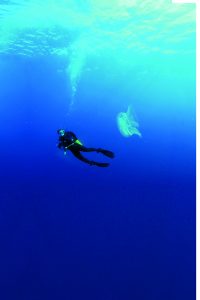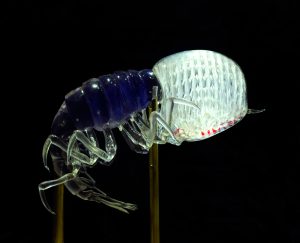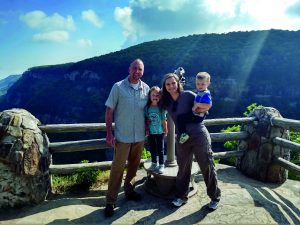On a walk one day, Jamie Baldwin Fergus’ graduate school advisor asked her if it all ended tomorrow, would she be happy?
Appears InEven though she was only in her 20s at the time, Fergus was content. She had earned her undergraduate degree in biological sciences at Illinois State in 2005, and was completing a doctorate in biology. She had been doing research dives in the north Atlantic, swimming around the bells of giant jellyfish.
As she was trying to figure out what her next step would be after earning her Ph.D. at Duke University, she wondered if she’d be jobless. Instead, she was offered a two-year Peter Buck Fellowship at the Smithsonian National Museum of Natural History.
Her time was split between North Carolina and Illinois, where her husband and state trooper, Josh, lived. She was a long way from where she grew up in Shumway, Illinois. Just a spot on the map, it is where she grew up pulling her mother’s tulips apart and examining them under a microscope.
The distance was not a problem, as she primarily worked from Illinois and trekked to the Smithsonian once a month or so to pick up specimens. When she was at the museum, she found it hard to believe she was walking through the historical galleries on the way to her office. There she continued work on what crustaceans can see, research she began at Duke.
Fergus specifically looked at the eyes of hyperiid amphipods—small crustaceans that live as far as a half mile deep in the ocean. More than 300 species have been identified. She was captivated by the four-eyed Paraphronima gracilis.
Smaller than a dime and resembling its distant relative, the shrimp, the creature is translucent except for orange eyeballs that make up half of its body. Two bulbous eyes with a row of 12 orange retinas look upward. There’s an eye on each side of its body too.
The Robert G. Bone Scholar talks in a rather non-scientific way about the “seriously weird” structure of the creature that has evolved to be able to see in the twilight zone of the ocean. Beyond the deep blue water, the ocean becomes pitch black. The only source of light is bioluminescence, which is the light emitted from sea creatures, similar to flashes from a lightning bug.
With no shore or ocean bottom in its habitat, there’s no place to hide. Seeing without being seen is the key to survival. Fergus has done complicated calculations on how light is absorbed by the creature to try and determine what it can see. She believes multiple retinas send electrical signals to the brain, allowing it to see in nearly complete darkness.
Having four eyes, with two searching for overhead targets, allows the Paraphronima to seek out hosts like jellyfish. The creature lives on or near jellyfish, feeding on their leftovers.
A Smithsonian model maker created a 13-inch sculpture of Fergus’ work for an exhibit in the museum’s Sant Ocean Hall. What was supposed to be a two-year exhibit has become permanent.
When her fellowship ended, Fergus decided to leave the east coast metropolitan life and settle into rural Illinois life in the community of Mason—a place a GPS cannot find.
It’s there she and Josh are raising their children, Olivia, 6, and Mack, 4, along with two dogs—including a one-eyed, three-legged Great Pyrenees. Although her home is 700 miles from her Smithsonian life, it’s near family so her children can have a close relationship with their grandparents.
Her home displays her past and present. An antique bookcase holds a zoology book; two pairs of worn baby shoes; and “Fred the Dead,” a 12-inch long isopod she describes as a giant roly poly. A red microscope she received when she was 3 also finds space there. (Both are shown in photo on page 8.) Her daughter occasionally peers through the instrument that Fergus used to view slides decades ago.
The items remind Fergus of her path. She might have become a veterinarian, but her experiences at Illinois State sent her in another direction. Biology Professor Martha Cook offered her a research position her freshman year. For three summers, she worked as a research fellow with now retired biology professors Robert Preston and George Kidder, who were awarded a National Science Foundation grant to study killifish.
Preston remembers Fergus as a bright and committed student who did exceptional research. “It’s very satisfying when a student catches fire doing basic research like Jamie did,” he said. “She just loved it, and to see her get deeply involved and make original contributions to basic science is most rewarding.”
Although Fergus remains a research associate at the Smithsonian, she’s put her ground-breaking science on hold. She turned down biology faculty positions that would have required 60-hour work weeks. Instead, she took a job in 2016 as a plant and pesticide specialist for the Illinois Department of Agriculture, inspecting medical cannabis facilities. Everything that happens in the cultivation centers, from seed to sale, has to be monitored.
The work is a long way from exploring the ocean in a submersible and doing blue water dives among jellyfish. But there is no sacrifice here.
“Here my kids can go outside. They have a pasture. Someday, I’ll get a donkey,” Fergus said. When she misses science, she can go to a fridge stocked with vials of nearly invisible crustaceans. “I have a little space in my basement for research when time allows, and to continue working on things if the mood strikes.”
“I’ve had wonderful experiences in science, and now I’m having a big adventure in parenthood.”
In a few years, when her children need her a little less, she’ll have time to get back to scientific research, she said.
“I’ve had wonderful experiences in science, and now I’m having a big adventure in parenthood. I never dreamed I’d be doing what I’m doing now, but that’s OK. No regrets. I’m happy to be taking care of my family. Work is no longer the number one thing in my life.”
Nearly a decade after that conversation with her advisor, Fergus can still say she’d make the same choices all over again. She remains completely content.




